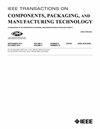Low-Cost Functional Testing Based on Data Imputation Integrating Fault Tree Analysis and XGBoost
IF 3
3区 工程技术
Q2 ENGINEERING, ELECTRICAL & ELECTRONIC
IEEE Transactions on Components, Packaging and Manufacturing Technology
Pub Date : 2025-07-15
DOI:10.1109/TCPMT.2025.3589029
引用次数: 0
Abstract
Functional testing is essential for ensuring the quality of electronic products. As system complexity increases, the cost of functional testing—particularly during the motherboard testing stage—has risen significantly. Designing an efficient testing strategy is therefore key to reducing overall testing costs. Although data imputation methods can enhance the effectiveness of strategies by addressing missing data, current approaches do not adequately account for the impact of correlation information between system modules on the input information of the data imputation model. This oversight results in suboptimal imputation performance, making it challenging to further reduce testing costs. To overcome this limitation, we propose a data imputation method that integrates fault tree analysis (FTA) with eXtreme gradient boosting (XGBoost), effectively combining system fault mode analysis with data-driven modeling. First, faults in nonbus data transmission are additionally considered, and an enhanced fault tree for motherboard testing is constructed. Next, correlations among system modules are quantitatively represented as system event associations within the fault tree, based on which the attributes requiring imputation are determined. Then, a top–down quantitative analysis method driven by both mechanisms and data is introduced to infer the states of basic events from intermediate event states. This mapping from intermediate events to basic events reduces the proportion of missing data. Based on this, missing values are imputed using the tree-based XGBoost model. Experiments conducted on transformed real-world manufacturing data demonstrate that effective testing strategies can be dynamically developed under varying conditions using the proposed method. Testing costs are reduced by up to 5.64% in high-yield scenarios, 6.66% in low-yield scenarios, and 7.07% during long-term yield fluctuations. Furthermore, the defect level is reduced by as much as 51.02%.集成故障树分析和XGBoost的数据插补低成本功能测试
功能测试是保证电子产品质量的必要手段。随着系统复杂性的增加,功能测试的成本(特别是在主板测试阶段)显著增加。因此,设计一个有效的测试策略是降低总体测试成本的关键。虽然数据插入方法可以通过解决缺失数据来提高策略的有效性,但目前的方法没有充分考虑系统模块之间的相关信息对数据插入模型输入信息的影响。这种疏忽导致了次优的输入性能,使得进一步降低测试成本变得具有挑战性。为了克服这一限制,我们提出了一种将故障树分析(FTA)与极限梯度增强(XGBoost)相结合的数据输入方法,将系统故障模式分析与数据驱动建模有效地结合起来。首先,考虑了非总线数据传输中的故障,构建了用于主板测试的增强故障树。接下来,系统模块之间的相关性被定量地表示为故障树中的系统事件关联,根据故障树确定需要输入的属性。然后,引入由机制和数据驱动的自顶向下定量分析方法,从中间事件状态推断基本事件的状态。这种从中间事件到基本事件的映射减少了丢失数据的比例。在此基础上,使用基于树的XGBoost模型输入缺失值。在转换后的真实制造数据上进行的实验表明,使用该方法可以在不同条件下动态开发有效的测试策略。测试成本在高收益情景下可降低5.64%,在低收益情景下可降低6.66%,在长期收益波动情况下可降低7.07%。此外,缺陷水平减少了51.02%。
本文章由计算机程序翻译,如有差异,请以英文原文为准。
求助全文
约1分钟内获得全文
求助全文
来源期刊

IEEE Transactions on Components, Packaging and Manufacturing Technology
ENGINEERING, MANUFACTURING-ENGINEERING, ELECTRICAL & ELECTRONIC
CiteScore
4.70
自引率
13.60%
发文量
203
审稿时长
3 months
期刊介绍:
IEEE Transactions on Components, Packaging, and Manufacturing Technology publishes research and application articles on modeling, design, building blocks, technical infrastructure, and analysis underpinning electronic, photonic and MEMS packaging, in addition to new developments in passive components, electrical contacts and connectors, thermal management, and device reliability; as well as the manufacture of electronics parts and assemblies, with broad coverage of design, factory modeling, assembly methods, quality, product robustness, and design-for-environment.
 求助内容:
求助内容: 应助结果提醒方式:
应助结果提醒方式:


